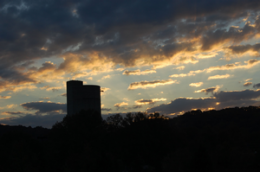Isotope near 'doubly magic' tin-100 flouts conventional wisdom

(PhysOrg.com) -- Tin may seem like the most unassuming of elements, but experiments performed at the Department of Energy's Oak Ridge National Laboratory are yielding surprising properties in extremely short-lived isotopes near tin-100's "doubly magic" nucleus.
Experiments performed with the exotic nucleus tin-101, which has a single neutron orbiting tin-100's closed shell of 50 protons and 50 neutrons, indicate an unexpected reversal in the ordering of lowest states in the nucleus. The finding appears to violate a standard scenario offered by the nuclear shell model that has been the cornerstone for understanding the atomic nucleus for more than half a century.
The international team of experimentalists and theorists was led by Iain G. Darby of the University of Tennessee (UT), who is now in Belgium, and Robert Grzywacz, a physics professor at UT and a former Wigner Fellow at ORNL. The experiment, performed at ORNL's Holifield Radioactive Ion Beam Facility, found that the ground states of orbiting neutrons unexpectedly swap when three neutrons are added to the closed-shell tin-100 nucleus.
"In fact, previously the ground state of tin-101 was assumed to be identical to that of tin-103, tin-105, and tin-107. Those conform to the standard picture. But we've found that tin-101 has a flipped ground state," Grzywacz said.
The researchers theorize that the swapping of ground-state spins between tin-101 and tin-103 is due to the neutrons' unusually strong orbital dependence of the pairing interaction and the relatively small difference between orbital energy states in tin-101.
"Neutrons tend to dance in pairs, much like Cooper pairs of electrons in superconductors. But because their angular momentum adds to zero, the pairing shouldn't affect the spin of the nucleus if only few neutrons are involved" said ORNL and UT researcher Witold Nazarewicz.
Grzywacz and Nazarewicz explained that, in the standard shell model, the neutron pairing energy weakly depends on the particle's state. "But it so happens that pairing interaction is different in those two orbits, one with higher energy and one lower. It is orbital dependent," said Nazarewicz, who is scientific director at the Holifield Facility. "With tin-101, those properties are governed by one neutron. If you add two more neutrons, the ground state is determined by the neutron superconductivity, which is very unusual. "
"In practice, the final picture is the two neutrons pair strongly and kick out the third--odd--neutron in tin-103 into another orbit," said Grzywacz. "Three's a crowd."
The experiment required the unique radioactive ion beam capabilities of the Holifield Facility at ORNL, plus digital signal processing instrumentation developed at ORNL to measure the extremely fast alpha particle decays in the neutron-deficient and very unstable tin isotopes. Tin-101 was made in the decay of the extremely short-lived, lightest-known alpha emitter tellurium-105, which was previously discovered by the ORNL-UT team.
The theoretical calculations, based on parameter-free, state-of-the-art nuclear models, were performed in Oslo, Norway, and in Oak Ridge, Tenn.
"We were developing these experimental methods for almost a decade and, combined with advances in computational methods and access to supercomputers such as Jaguar and Kraken at ORNL, they are now bearing fruit," said Grzywacz.
The results of the research have been accepted for publication in Physical Review Letters.
Provided by Oak Ridge National Laboratory


















